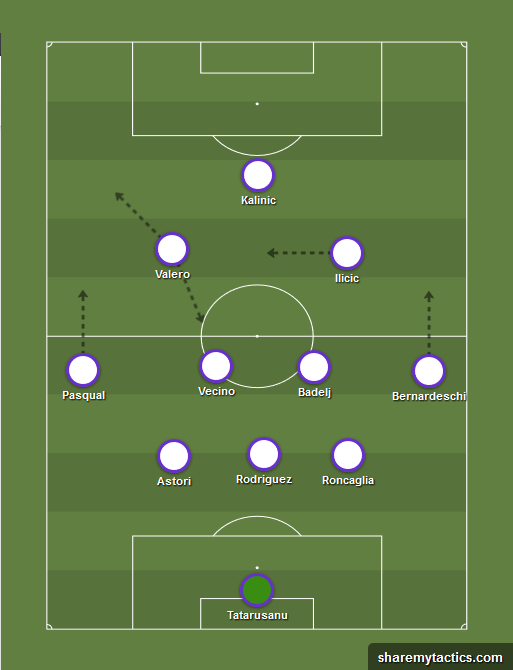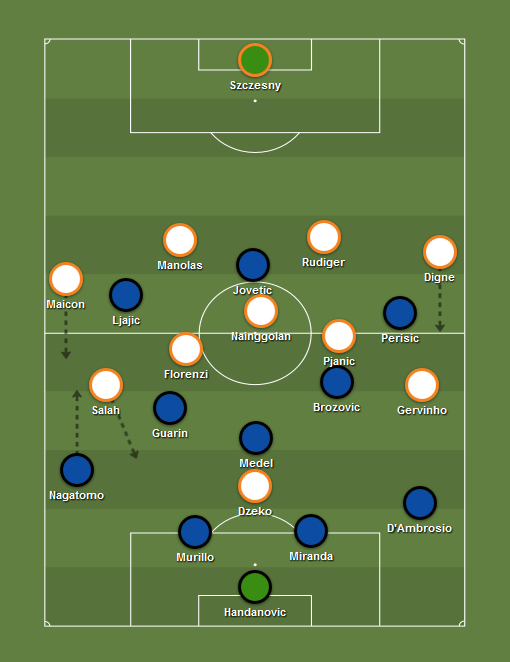Many saw this trip to the Marassi as a big test for Sousa’s team, with Sampdoria unbeaten at home so far this season. They came into the game off the back of a European tie three days prior, a trip to Poznan, albeit making a fair few changes. Bernardeschi occupied the right wing-back and Pasqual the left, seeing Roncaglia slot back into defence. Badelj came in for Suarez in the middle, and Valero moved back into the attacking midfield role, with Kalinic replacing Rossi up top. Samp took up a familiar 4-3-3, with their main danger being the pace and movement of Eder and Muriel on the break.

The match picked up quickly, with a fast-paced start, as the away side looked to use their wing-backs as an advantage, trying to provide options out wide going forward. Pasqual, in particular, got forward early on and Samp appeared to offer him too much space. Borja Valero was intent on closing down the opposition players on the ball in their own half in his section, on the left, and the home side weren’t generally allowed the space to build through midfield. However, the referee set a precedent of booking Badelj early on for tugging back Eder who was breaking away, followed by the same reprimand for Vecino shortly after. This could have been some concern for Viola, with both their central midfielders on bookings and unable to commit to risky tackles for the rest of the game. However, this never really materialised as an issue because of how Fiorentina put the emphasis of the game firmly upon their own possession of the ball, and never got in a position where they had to chase around in those areas.
The breakthrough came when Samp’s young full-back Pereira, playing for the first time on the left, was caught out of position and lost his man after Roncaglia played a long ball over the top. Bernardeschi cut in and flicked the ball up, prompting Zukanovic to inexplicably wave his arm at it and give away a penalty. Ilicic scored the resulting spot-kick, low and hard to Viviano’s left. This only served to inspire confidence into the away side, as they got men forward on the attack, and dominated possession. Bernardeschi looked dangerous coming forward down the right, on one occasion running with the ball and shooting just wide. Samp did manage to use their outlet of Muriel, as he burst away down the left, with Gonzalo booked for pulling him back at the byline, but the home side couldn’t utilise the counter at all well, and showed no great threat or intent at moving men into Fiorentina’s half. When they did pick up the ball in their own half, they were quick to pass it to an opposition player and lose any opportunity they had to catch Viola out of position.
Defensively Sampdoria seemed to struggle as well. Kalinic had a great chance to score, after a fantastic dink through from Badelj (shown in the image at the bottom, demonstrating the movement of the front two), but putting it wide of the post. The defensive line was poor – with one man out of position (yellow circled) and playing Kalinic onside. Sousa’s men continued to press high up the pitch if the opposition took too long on the ball in defence, disrupting the rhythm of the Blucerchiati, and pinning their play back. All the while, Eder and Muriel were becoming completely isolated from the play and a void would appear between them and the midfield whenever they had the ball. If anything, Viola were the more proficient on the counter, with Ilicic breaking this time, although the final pass being offside. Samp did have a brief spell where they tried to rally before half-time, as the noise from the crowd intensified. Muriel still looked lively, despite a lack of service, and he got onto the end of a long ball, after Astori failed to deal with it, but the resulting opportunity was blazed over by Baretto with a clear chance failing to materialise. All the same, it was some hope for the home side, and Fernando was trying his best to gee up the supporters.


